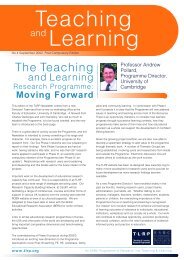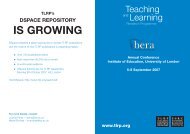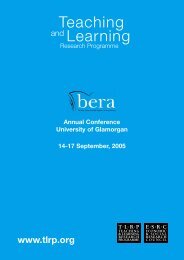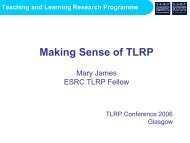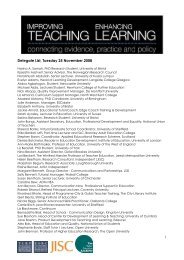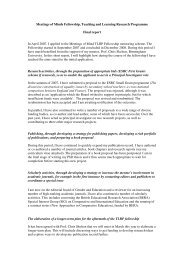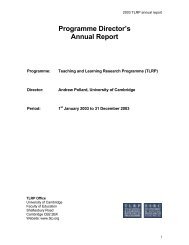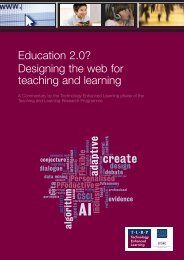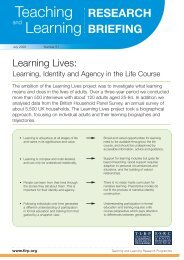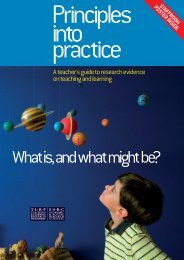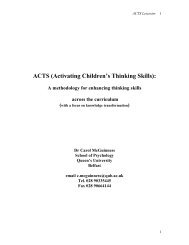Issue 2: the qualitative foundation of quantity - Teaching and ...
Issue 2: the qualitative foundation of quantity - Teaching and ...
Issue 2: the qualitative foundation of quantity - Teaching and ...
You also want an ePaper? Increase the reach of your titles
YUMPU automatically turns print PDFs into web optimized ePapers that Google loves.
Qualitative research in education<br />
(Continued from page 4)<br />
ample, if all <strong>of</strong> <strong>the</strong> treated plants<br />
died <strong>and</strong> all <strong>of</strong> <strong>the</strong> o<strong>the</strong>rs survived<br />
(or vice versa) <strong>the</strong>n we do not need<br />
a significance test to tell us that <strong>the</strong><br />
probability is very low (<strong>and</strong> precisely<br />
how low depends on <strong>the</strong><br />
number <strong>of</strong> plants involved) that <strong>the</strong><br />
treatment had no effect. If <strong>the</strong>re<br />
were 1,000 plants in <strong>the</strong> sample for<br />
each colony, <strong>and</strong> one survived in<br />
<strong>the</strong> treated group, <strong>and</strong> one died in<br />
<strong>the</strong> o<strong>the</strong>r group, <strong>the</strong>n again a significance<br />
test would be superfluous<br />
(<strong>and</strong> so on). All that <strong>the</strong> test is doing<br />
is formalising <strong>the</strong> estimates <strong>of</strong> relative<br />
probability that we make anyway<br />
in everyday situations. They<br />
are really only needed when <strong>the</strong><br />
decision is not clear-cut (for example<br />
where 600/1000 survived in <strong>the</strong><br />
treated group but only 550/1000<br />
survived in <strong>the</strong> control), <strong>and</strong> since<br />
<strong>the</strong>y do not make <strong>the</strong> decision for<br />
us, <strong>the</strong>y are <strong>of</strong> limited practical use<br />
even <strong>the</strong>n.<br />
It is also important to emphasise<br />
that <strong>the</strong> probabilities generated by<br />
significance tests are based on r<strong>and</strong>om<br />
samples. If <strong>the</strong> researcher<br />
does not use a r<strong>and</strong>om sample <strong>the</strong>n<br />
inferential statistics are <strong>of</strong> little use<br />
since <strong>the</strong> probabilities become<br />
meaningless. Researchers using<br />
significance tests with convenience,<br />
quota or snowball samples, for example,<br />
are making a key category<br />
mistake. Similarly, researchers using<br />
significance tests on populations<br />
(from <strong>of</strong>ficial statistics perhaps)<br />
are generating meaningless<br />
probabilities. It is possible that a<br />
trawl <strong>of</strong> educational, psychology or<br />
sociology research journals would<br />
reveal very few, technically, correct<br />
uses <strong>of</strong> significance tests. Added to<br />
this is <strong>the</strong> problem that social scientists<br />
are not generally dealing with<br />
variables, such as plant survival<br />
rates, with minimal measurement<br />
error. In fact, many studies are<br />
based on latent variables, such as<br />
attitudes, <strong>of</strong> whose existence we<br />
cannot even be certain, let alone<br />
how to measure <strong>the</strong>m. Added to<br />
this are <strong>the</strong> problems <strong>of</strong> nonresponse<br />
<strong>and</strong> participant dropout in<br />
social investigations, that also do<br />
not occur in agricultural applications.<br />
All <strong>of</strong> this means that <strong>the</strong><br />
variation in observed measurements<br />
due to <strong>the</strong> chance factor <strong>of</strong><br />
sampling (which is all that significance<br />
tests take into account) is<br />
generally far less than <strong>the</strong> potential<br />
variance due to o<strong>the</strong>r factors. The<br />
probability from a test contains <strong>the</strong><br />
unwritten proviso - assuming that<br />
<strong>the</strong> sample is r<strong>and</strong>om with full response,<br />
no dropout, <strong>and</strong> no measurement<br />
error. The number <strong>of</strong> educational<br />
studies meeting this proviso<br />
are very small indeed. To this<br />
must be added <strong>the</strong> caution that<br />
probabilities interact, <strong>and</strong> that most<br />
analyses in <strong>the</strong> IT age are no longer<br />
one-<strong>of</strong>f (for more on this more complex<br />
issue see Gorard 2001). Most<br />
analysts start each probability calculation<br />
as though nothing prior is<br />
known, whereas it may be more realistic<br />
<strong>and</strong> cumulative to build <strong>the</strong><br />
results <strong>of</strong> previous work into new<br />
calculations (as in meta-analysis,<br />
<strong>and</strong> in Bayesian models).<br />
In conclusion, while it is important<br />
for novice social scientists to be<br />
taught about <strong>the</strong> use <strong>of</strong> significance<br />
tests, it is equally important that<br />
<strong>the</strong>y are taught about <strong>the</strong> limitations<br />
as well (<strong>and</strong> alternatives, such as<br />
confidence intervals, effect sizes,<br />
<strong>and</strong> graphical approaches will be<br />
addressed in future issues <strong>of</strong> this<br />
journal). Significance tests have a<br />
specific valuable role to play in a<br />
limited range <strong>of</strong> research situations.<br />
Statistics cannot be used post hoc<br />
to overcome design problems or<br />
deficiencies in datasets. If all <strong>of</strong> <strong>the</strong><br />
treated plants in our example were<br />
placed on <strong>the</strong> lighter side <strong>of</strong> <strong>the</strong><br />
greenhouse, with <strong>the</strong> control group<br />
on <strong>the</strong> o<strong>the</strong>r side, <strong>the</strong>n <strong>the</strong> most sophisticated<br />
statistical analysis in <strong>the</strong><br />
world could not overcome that bias.<br />
It is worth stating this because <strong>of</strong><br />
<strong>the</strong> current push for more complex<br />
methods <strong>of</strong> probability-based analysis<br />
when a more fruitful avenue for<br />
long-term progress would be <strong>the</strong><br />
generation <strong>of</strong> better data, open to<br />
inspection through simpler <strong>and</strong><br />
more transparent methods <strong>of</strong> accounting.<br />
Gorard, S. (2001) Quantitative methods<br />
in educational research: <strong>the</strong> role<br />
<strong>of</strong> numbers made easy, London:<br />
Continuum.<br />
Reflections on <strong>the</strong> history <strong>of</strong> <strong>qualitative</strong> research in<br />
education<br />
Am<strong>and</strong>a C<strong>of</strong>fey<br />
Cardiff University School <strong>of</strong> Social Sciences<br />
This paper considers <strong>the</strong> role <strong>of</strong><br />
‘<strong>qualitative</strong>’ work within educational<br />
research, <strong>and</strong> addresses <strong>the</strong> capacity<br />
<strong>of</strong> such work to respond to contemporary<br />
developments <strong>and</strong> debates.<br />
Qualitative research in education<br />
has been <strong>the</strong> subject <strong>of</strong><br />
some criticism in recent years. Debates<br />
about <strong>the</strong> generalizability <strong>of</strong><br />
<strong>qualitative</strong> evidence <strong>and</strong> <strong>the</strong> role <strong>of</strong><br />
political motivation in <strong>qualitative</strong><br />
studies have both been well rehearsed<br />
in <strong>the</strong> education literature<br />
(Foster et al 1996). These issues<br />
are not confined to <strong>qualitative</strong> research<br />
in education, nor are <strong>the</strong>y<br />
new to <strong>qualitative</strong> scholars more<br />
generally. They have, however,<br />
played a key part in dialogues<br />
about <strong>the</strong> quality <strong>and</strong> st<strong>and</strong>ards <strong>of</strong><br />
educational research. For some<br />
commentators this has led to a call<br />
for <strong>the</strong> confining <strong>of</strong> <strong>qualitative</strong> work<br />
to <strong>the</strong> outskirts <strong>of</strong> educational research<br />
– <strong>and</strong> to an argument that<br />
<strong>qualitative</strong> data should primarily be<br />
used for anecdotal <strong>and</strong> illustration<br />
purposes (Tooley 1997). The consequences<br />
<strong>of</strong> such a position for<br />
(Continued on page 6)<br />
April 2002 Building Research Capacity 5



